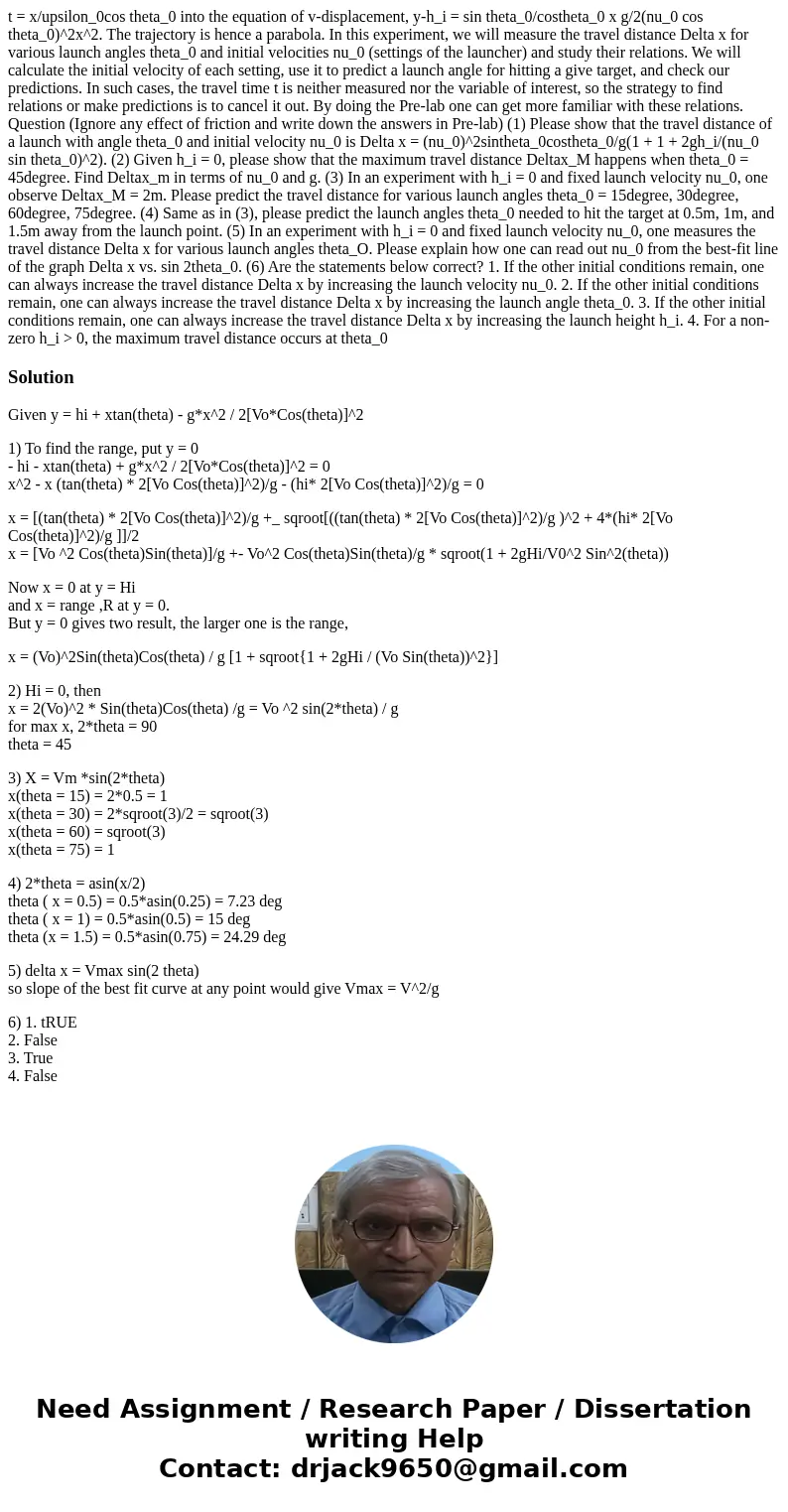t = x/upsilon_0cos theta_0 into the equation of v-displacement, y-h_i = sin theta_0/costheta_0 x g/2(nu_0 cos theta_0)^2x^2. The trajectory is hence a parabola. In this experiment, we will measure the travel distance Delta x for various launch angles theta_0 and initial velocities nu_0 (settings of the launcher) and study their relations. We will calculate the initial velocity of each setting, use it to predict a launch angle for hitting a give target, and check our predictions. In such cases, the travel time t is neither measured nor the variable of interest, so the strategy to find relations or make predictions is to cancel it out. By doing the Pre-lab one can get more familiar with these relations. Question (Ignore any effect of friction and write down the answers in Pre-lab) (1) Please show that the travel distance of a launch with angle theta_0 and initial velocity nu_0 is Delta x = (nu_0)^2sintheta_0costheta_0/g(1 + 1 + 2gh_i/(nu_0 sin theta_0)^2). (2) Given h_i = 0, please show that the maximum travel distance Deltax_M happens when theta_0 = 45degree. Find Deltax_m in terms of nu_0 and g. (3) In an experiment with h_i = 0 and fixed launch velocity nu_0, one observe Deltax_M = 2m. Please predict the travel distance for various launch angles theta_0 = 15degree, 30degree, 60degree, 75degree. (4) Same as in (3), please predict the launch angles theta_0 needed to hit the target at 0.5m, 1m, and 1.5m away from the launch point. (5) In an experiment with h_i = 0 and fixed launch velocity nu_0, one measures the travel distance Delta x for various launch angles theta_O. Please explain how one can read out nu_0 from the best-fit line of the graph Delta x vs. sin 2theta_0. (6) Are the statements below correct? 1. If the other initial conditions remain, one can always increase the travel distance Delta x by increasing the launch velocity nu_0. 2. If the other initial conditions remain, one can always increase the travel distance Delta x by increasing the launch angle theta_0. 3. If the other initial conditions remain, one can always increase the travel distance Delta x by increasing the launch height h_i. 4. For a non-zero h_i > 0, the maximum travel distance occurs at theta_0
Given y = hi + xtan(theta) - g*x^2 / 2[Vo*Cos(theta)]^2
1) To find the range, put y = 0
- hi - xtan(theta) + g*x^2 / 2[Vo*Cos(theta)]^2 = 0
x^2 - x (tan(theta) * 2[Vo Cos(theta)]^2)/g - (hi* 2[Vo Cos(theta)]^2)/g = 0
x = [(tan(theta) * 2[Vo Cos(theta)]^2)/g +_ sqroot[((tan(theta) * 2[Vo Cos(theta)]^2)/g )^2 + 4*(hi* 2[Vo Cos(theta)]^2)/g ]]/2
x = [Vo ^2 Cos(theta)Sin(theta)]/g +- Vo^2 Cos(theta)Sin(theta)/g * sqroot(1 + 2gHi/V0^2 Sin^2(theta))
Now x = 0 at y = Hi
and x = range ,R at y = 0.
But y = 0 gives two result, the larger one is the range,
x = (Vo)^2Sin(theta)Cos(theta) / g [1 + sqroot{1 + 2gHi / (Vo Sin(theta))^2}]
2) Hi = 0, then
x = 2(Vo)^2 * Sin(theta)Cos(theta) /g = Vo ^2 sin(2*theta) / g
for max x, 2*theta = 90
theta = 45
3) X = Vm *sin(2*theta)
x(theta = 15) = 2*0.5 = 1
x(theta = 30) = 2*sqroot(3)/2 = sqroot(3)
x(theta = 60) = sqroot(3)
x(theta = 75) = 1
4) 2*theta = asin(x/2)
theta ( x = 0.5) = 0.5*asin(0.25) = 7.23 deg
theta ( x = 1) = 0.5*asin(0.5) = 15 deg
theta (x = 1.5) = 0.5*asin(0.75) = 24.29 deg
5) delta x = Vmax sin(2 theta)
so slope of the best fit curve at any point would give Vmax = V^2/g
6) 1. tRUE
2. False
3. True
4. False

 Homework Sourse
Homework Sourse